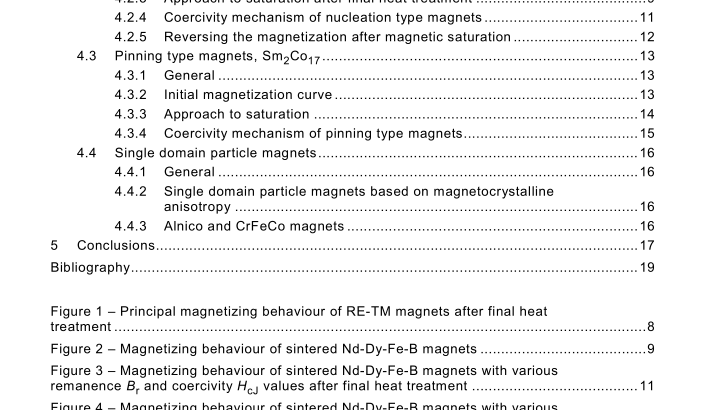IEC TR 62517:2009 pdf download – Magnetizing behaviour of permanent magnets
3 Initial magnetization state For nucleation type ferrite, SmCo5 and REFeB magnets, the initial state prior to magnetizing is usually the state after the final heat treatment, i.e. after sintering. This state shows no net remanent magnetization and is often called the thermally demagnetized, or virgin, state. Ferrite and REFeB magnets, once magnetized, may be reset to the initial state by heating them to above the Curie temperature. This will return them to the thermally demagnetized state without permanent loss of properties. SmCo 5 magnets can be reset to the initial state only by repeating the full final heat treatment. To prevent chemical changes which can lead to surface damage and permanent loss of properties, rare earth magnets shall be protected in an inert atmosphere during this procedure. For anisotropic Alnico and CrFeCo magnets, where heat treatment in a magnetic field and tempering are involved, some residual magnetization may remain in the magnets. These magnets may be completely demagnetized from any degree of magnetization by applying a slowly reducing alternating magnetic field. The same holds for any pinning or single domain type magnet such as Sm 2 Co 1 7 and rapidly quenched or HDDR-treated REFeB magnets.
4 Magnetizing behaviour of permanent magnets
4.1 General The magnetizing behaviour of permanent magnets is closely related to their coercivity mechanisms, therefore they need to be discussed. Modern permanent magnets may be divided into three groups with respect to their coercivity mechanism. The principal magnetization behaviour for these groups, the nucleation type, the pinning type and the single domain particle type is illustrated in Figure 1 .
4.2 Nucleation type magnets, sintered Ferrites, RE-Fe-B, SmCo 5 4.2.1 General The commercially very important sintered Ferrites, RE-Fe-B and SmCo 5 magnets are nucleation type materials. In the following discussion, the magnetization behaviour of nucleation type magnets will be discussed using anisotropic sintered RE-Fe-B magnets as an example.
4.2.2 Initial magnetization curve after final heat treatment For nucleation type magnets such as sintered Ferrites and Rare Earth Transition Metal (RE- TM) magnets based on Nd-Fe-B or SmCo 5 , the grains contain multiple magnetic domains after final heat treatment. The magnetic domains are separated by domain walls which can move easily within the grains, so that the polarization increases steeply, even in small magnetizing fields, see Figure 1 a) [2]. For sintered RE-Fe-B magnets, a polarization of about 95 % of the saturation polarization results even after magnetizing with a small magnetizing field strength of about 200 kA/m.
4.2.3 Approach to saturation after final heat treatment The polarization decreases, once a low magnetizing field is removed, since no significant coercivity H cJ has been developed. In the multidomain grains, the domain walls are free to move back toward their original positions, to minimize the magnetic stray field energy, see Figure 2.
The demagnetization curves J(H) were measured on different samples, each in the state after the final heat treatment, after magnetization by the indicated field strengths H mag . For complete magnetization an applied field of 2 000 kA/m is recommended. Magnetization by a field strength of about 500 kA/m saturates some grains, resulting in some coercivity.
Such grains do not contain domain walls anymore. Since most of the grains are still multidomain, the J(H) demagnetization curves of such partially magnetized magnets show a very poor squareness, see Figure 2. To saturate a nucleation type magnet after final heat treatment, all domain walls within every single grain must be removed. To achieve this, the internal field strength must become positive at every point in the material, since strong local demagnetizing stray fields can occur at the grain edges [3,4]. The magnitude of the local stray fields can be estimated from the following equation:
J denotes the polarization of the magnet material and N eff presents an effective demagnetization coefficient, which depends on the local microstructure. In practice, N eff can be of the order of two [4]. As a result, perfect saturation requires a magnetizing field strength of at least twice the saturation polarization J s (divided by μ 0 ) of the magnet material [4,5]. For the RE-Fe-B magnet shown in Figure 2, complete magnetization requires a strong internal field strength of more than 1 600 kA/m. In that case, nearly every grain is saturated: hardly any grains contain small reversed domains.IEC TR 62517 pdf download.
